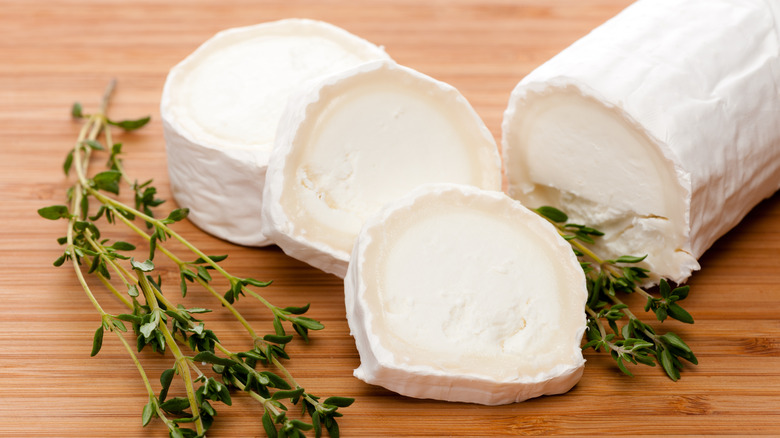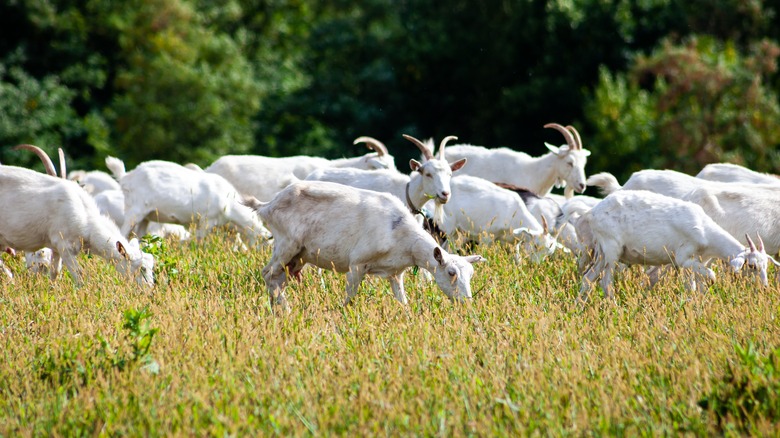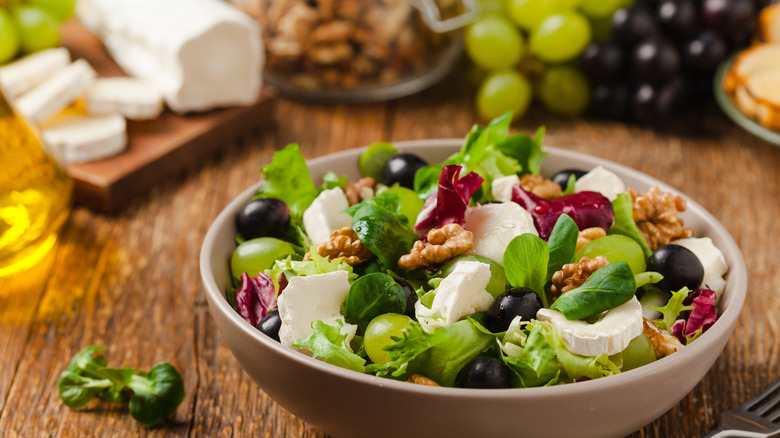You Should Stop Believing This Myth About Goat Cheese
A good cheese plate or charcuterie board benefits from an inviting, tangy log of goat cheese, also known as chèvre (say "SHEV-ruh," according to Merriam-Webster) — from the French word for goat. Goat cheese is in a class of its own. Cheese Science explains that goat cheese has a high concentration of fatty acids, giving it a sweet, tart flavor some describe as tangy. Whether you like it spread on crackers or crumbled over a salad, you likely know goat cheese for this flavor. While MasterClass explains that goat's milk cheeses contain more fat than cow's milk cheeses, they also have more minerals and less lactose — making them potentially easier to digest for people with lactose intolerance.
But there's more to goat cheese than the white, creamy stuff that serves as most eaters' entry point into this culinary microcosm. iGourmet reports that it was first produced in the Middle East and Mediterranean regions, where goats outnumbered cattle, though France popularized the fresh soft goat cheese called chèvre. However, iGourmet adds that goat cheese comes in many forms and flavors, so if its goaty taste and challenging texture aren't your things, you should know that there's still a world of goat's milk cheese awaiting you.
Goat cheese isn't all soft, strong, or French
Chèvre is widespread (pun intended) — and dominates the United States' goat cheese market (per Cook's Illustrated). But it's far from the only type of goat cheese out there. MasterClass writes that you can make nearly any cheese from goat's milk, including hard and blue cheeses, brie, cheddar, and gouda. Cook's Illustrated explains that factors like the goats' breed and diet, the kinds of mold, and the aging and ripening processes of goat cheese all affect the final product's appearance, texture, and flavor.
TasteAtlas reports that popular American goat cheeses include Vermont's ash-coated Bonne Bouche and tiny, tasty Bijou. They also shout out Midnight Moon, Truffle Tremor, Purple Haze, and Humboldt Fog by Cypress Grove in California. Midnight Moon is a Netherlands-produced gouda aged 6-12 months — a very firm and nuanced cheese. Truffle Tremor has a stiff rind housing a black truffle-studded, soft center, and spreadable Purple Haze is coated in pollen from wild fennel and lavender.
Shopping for goat cheese and cooking with it
You can find goat cheeses online, at farmer's markets, or specialty grocers with gourmet sections or cheese counters. Don't be afraid to ask for a taste! Cheese shops sell by the pound, making it easy to get the amount of goat cheese you need without breaking the bank. Enjoy the cheeses on their own, or add them to your cooking repertoire. Celebrity chef goat cheese recipes range from simple to complex, just like the cheese itself. Comfort food queen Ina Garten offers breaded, fried warm goat cheese — a tangy twist on classic mozzarella sticks. Alton Brown sprinkles soft chèvre atop his crunchy tossed beet salad, and Ree Drummond created baked goat cheese pasta sure to win any foodie's heart. Also, you can't go wrong with fondue.
Sweet and savory flavors, fresh herbs, spices, lemon, and honey are all friends of goat's milk cheese. Try goat cheese nasturtium ice cream — made with edible flowers — or Anne Burrell's goat cheese cheesecake for something out of the ordinary. MasterClass reminds us that goat cheese softens when heated rather than melting like cow's milk cheese, making it suitable for adding to soup and pesto or subbing in for ricotta in Italian dishes. With Healthline's report of goat cheese as a satisfyingly rich, probiotic, vitamin-packed animal food, and the endorsement of chefs and foodies the world over, it's time to look beyond the pale, goaty log and embrace goat cheese of all types.


